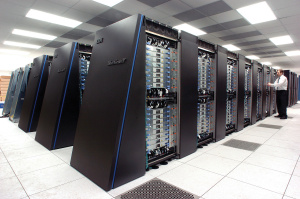Pinnacle of global technology seeks to take blockchain past Bitcoin and money transfer
North American multinational technology IBM has begun its mission to take the highly valuable Blockchain technology to what it considers to be a level beyond the realms of Bitcoin and international money transfer. There are two very interesting points with regard to this corporate direction by IBM, one being that a large multinational technology company […]

North American multinational technology IBM has begun its mission to take the highly valuable Blockchain technology to what it considers to be a level beyond the realms of Bitcoin and international money transfer.
There are two very interesting points with regard to this corporate direction by IBM, one being that a large multinational technology company would view the intrinsically peer to peer nature of Blockchain, which is a permissionless distributed database based on the bitcoin protocol that maintains a continuously growing list of data records hardened against tampering and revision, even by its operators, as a commercial asset long term, and the other being IBM’s wish to extend Blockchain beyond the virtual currency that it is until now inseparably connected to.
During 2015, some very large venture capital investments were made into Bitcoin startups, the rationale being not to back Bitcoin as a virtual currency, but to stimulate the development of Blockchain as a technology which can be used by large financial institutions to automate certain procedures.
Indeed, record amounts of capital have been invested thus far, including a $116 million round of funding into 21 Inc for its Blockchain technology.
Earlier this week, IBM stated that it has been working on facilitating much easier usability for Blockchain so that business can use it for financial and non financial purposes.
During its inaugural years, Bitcoin was synonymous with self-styled mavericks who sought to circumvent central banks and national economies, underground market pkaces such as Silk Road which was seized by the US government for illicit activity, and the black market in regions with strict capital controls such as Argentina, where Bitcoin values soared to over 30% higher than in neighboring Uruguay due to the popularity of virtual currencies in Argentina as a means of circumventing former President Cristina Kirchner’s ban on the US dollar and stringent capital control laws, tying citizens to an inflationary Peso.
Values of Bitcoin fluctuated dramatically throughout its infancy, and then all of a sudden national regulatory authorities began granting licenses to operate bona fide Bitcoin exchanges, and the large venture capital funds began to invest hundreds of millions of dollars in Bitcoin technology.
It is clear, however, that Bitcoin itself was not the focus, but rather the underlying Blockchain technology which is completely inseparable from Bitcoin, therefore until now, institutions wanting to develop Blockchain related automated services are stuck with Bitcoin as a byproduct, whether intended or not.
Management consultancy McKinsey recently stated that banks should work together with regard to the development of Bitcoin technology, and Goldman Sachs, Barclays, JPMorgan and UBS have all begun investing in the development of blockchain, however this initiative by IBM is the first R&D exercise ever that has sought to remove Blockchain from its intrinsic partner, Bitcoin.
The concept of applying Blockchain technology outside of the realms of Bitcoin is a major step, which was initially highlighted to FinanceFeeds CEO Andrew Saks-McLeod at a meeting in New York in the summer of 2015 by Daniel Gallancy, CEO and Founding Member of SolidX Partners, who explained
“There is a question of semantics. Within the Bitcoin community, when I refer to the Blockchain as the trustless ledger, others outside the Bitcoin community refer to it as a permission ledger, and this is an interesting perspective. We can have a permission ledger that can facilitate fast transactions but I refer to the Bitcoin Blockchain as the trustless ledger.”
This type of Blockchain application is known as ‘distributed ledger technology’ because the need for a centralized database is removed, and every transaction in a particular system is given a cryptographic hash which can be checked by any member of the network as per the mining process of Bitcoin.
IBM is targeting its new blockchain efforts not only at potential financial-industry customers, but at a variety of logistics customers as well.
IBM spokesperson Holli Haswell has stated in ArsTechnica recently about the move outside the financial sector and into logistics in that a good example for a non-monetary use of a distributed ledger could be shipping. If a business is trying to ship food across the county, the companies in contract with one another could “apply contract resolution and auditing to the blockchain if for instance a shipment of food is spoiled, allowing you to see the temperature of the cargo container throughout the shipping process.”
In such a scenario, shipments would be outfitted with RFID tags and sensors that could record temperature, location, and any number of other statistics that could be reported back to the distributed ledger.
Photograph: IBM Blue Gene P Supercomputer.









